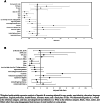Exploring factors associated with hepatitis B screening in a multilingual and diverse population
- PMID: 35410249
- PMCID: PMC8996655
- DOI: 10.1186/s12913-022-07813-w
Exploring factors associated with hepatitis B screening in a multilingual and diverse population
Abstract
Background: Racial/ethnic minorities bear a disproportionate burden of hepatitis B virus (HBV) infection and disease. Disparities in HBV screening contribute to worse outcomes for communities of color. We examined the impact of race/ethnicity, language preference, and having a usual place of care on HBV screening in a multilingual, urban cohort.
Methods: We used questions from the Health Information National Trends Survey and added validated questions about healthcare access and health literacy. We administered this survey in English, Spanish, and Chinese to a selected convenience sample of San Francisco city/county residents in 2017, with pre-specified targets for populations with known cancer disparities: 25% Spanish-speaking, 25% Chinese-speaking, and 25% Black Americans. Using weighted multivariable logistic regression analyses, we assessed how race/ethnicity, language preference, and having a usual place of care impacts self-report of HBV screening.
Results: Overall, 1027 participants completed the survey (50% of surveys administered in English, 25% in Spanish, and 25% in Chinese). Only 50% of participants reported HBV screening. In multivariable analysis, Black (OR = 0.20, 95% CI 0.08-0.49), Latinx (OR = 0.33, 95% CI 0.13-0.85), Asian (OR = 0.31, 95% CI 0.10, 0.94), and 'Other' race/ethnicity (OR = 0.17, 95% CI 0.05-0.53) respondents had lower odds of HBV screening compared to non-Hispanic White respondents. Participants who had insurance had increased odds of HBV screening (OR = 2.70, 95% CI 1.48-4.93).
Conclusions: HBV screening disparities persist for Black Americans, Asian Americans, Latinx, and the uninsured. Future studies should explore reasons why current strategies have not been implemented or are not successful, particularly in addressing racial/ethnic and insurance disparities.
Keywords: Hepatitis B; Language preference; Preventive medicine; Race/ethnicity; Screening.
© 2022. The Author(s).
Conflict of interest statement
The authors do not have any conflicts of interest to disclose.
Figures
Similar articles
-
Equitability of Depression Screening After Implementation of General Adult Screening in Primary Care.JAMA Netw Open. 2022 Aug 1;5(8):e2227658. doi: 10.1001/jamanetworkopen.2022.27658. JAMA Netw Open. 2022. PMID: 35980633 Free PMC article.
-
Racial and Ethnic Disparities in Diabetes Screening Between Asian Americans and Other Adults: BRFSS 2012-2014.J Gen Intern Med. 2017 Apr;32(4):423-429. doi: 10.1007/s11606-016-3913-x. Epub 2016 Nov 15. J Gen Intern Med. 2017. PMID: 27848187 Free PMC article.
-
The Use of Technology for Communicating With Clinicians or Seeking Health Information in a Multilingual Urban Cohort: Cross-Sectional Survey.J Med Internet Res. 2020 Apr 6;22(4):e16951. doi: 10.2196/16951. J Med Internet Res. 2020. PMID: 32250280 Free PMC article.
-
Comparing Ways to Increase Hepatitis B and C Screening among Asian Americans [Internet].Washington (DC): Patient-Centered Outcomes Research Institute (PCORI); 2020 Feb. Washington (DC): Patient-Centered Outcomes Research Institute (PCORI); 2020 Feb. PMID: 39808005 Free Books & Documents. Review.
-
Barriers to screening for hepatitis B virus infection in Asian Americans.Dig Dis Sci. 2011 Nov;56(11):3163-71. doi: 10.1007/s10620-011-1840-6. Epub 2011 Aug 23. Dig Dis Sci. 2011. PMID: 21861105 Review.
Cited by
-
Assessing Physicians' Recommendations for Hepatitis B Virus (HBV) and Hepatitis C Virus (HCV) Testing Among Minority Populations in Greater Philadelphia and New York City.J Community Health. 2024 Aug;49(4):588-597. doi: 10.1007/s10900-023-01316-3. Epub 2024 Jan 29. J Community Health. 2024. PMID: 38286964 Free PMC article.
-
Chronic Viral Hepatitis Screening Inequities Across Florida Federally Qualified Health Centers.J Racial Ethn Health Disparities. 2025 Mar 6. doi: 10.1007/s40615-025-02363-3. Online ahead of print. J Racial Ethn Health Disparities. 2025. PMID: 40048081
References
-
- People Born Outside of the United States and Viral Hepatitis . Centers for Disease Control and Prevention. 2020.
-
- Roberts H, Kruszon-Moran D, Ly KN, Hughes E, Iqbal K, Jiles RB, et al. Prevalence of chronic hepatitis B virus (HBV) infection in U.S. households: National Health and nutrition examination survey (NHANES), 1988-2012: HEPATOLOGY, Vol. XX, no. X, 2015. Hepatology. 2016;63(2):388–397. doi: 10.1002/hep.28109. - DOI - PubMed


